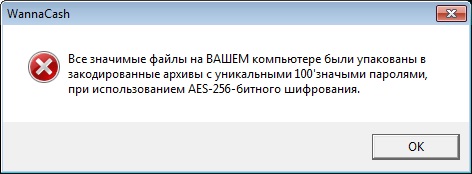Ransom.Win32.WANNACASH.A
Win32:RansomX-gen [Ransom] (AVAST); HEUR:Trojan-Ransom.Win32.Encoder.gen (KASPERSKY)
Windows


Threat Type: Ransomware
Destructiveness: No
Encrypted: No
In the wild: Yes
OVERVIEW
Downloaded from the Internet, Dropped by other malware
This Ransomware arrives on a system as a file dropped by other malware or as a file downloaded unknowingly by users when visiting malicious sites.
It drops files as ransom note.
TECHNICAL DETAILS
2,974,208 bytes
EXE
No
02 Mar 2020
Displays message/message boxes, Drops files
Arrival Details
This Ransomware arrives on a system as a file dropped by other malware or as a file downloaded unknowingly by users when visiting malicious sites.
Other System Modifications
This Ransomware adds the following registry entries:
HKEY_CURRENT_USER\Software\Microsoft\
Windows\CurrentVersion
esetsucks = go
Dropping Routine
This Ransomware drops the following files:
- %User Temp%\Public.key (contains Lockbox public key)
(Note: %User Temp% is the current user's Temp folder, which is usually C:\Documents and Settings\{user name}\Local Settings\Temp on Windows 2000(32-bit), XP, and Server 2003(32-bit), or C:\Users\{user name}\AppData\Local\Temp on Windows Vista, 7, 8, 8.1, 2008(64-bit), 2012(64-bit) and 10(64-bit).)
Other Details
This Ransomware displays the following message boxes:

It does the following:
- It encrypts files with the following strings:
- *.doc
- *.docx
- *.xls
- *.xlsx
- *.xlst
- *.ppt
- *.pptx
- *.accdb
- *.db
- *.pub
- *.epub
- *.pps
- *.ppsm
- *.pot
- *.pages
- *.odf
- *.odt
- *.ods
- *.djvu
- *.html
- *.rtf
- *.txt
- *.dat
- *.1Cv8ddb.1cl
- .1CD
- *.cf
- *.dt
- *.efd
- *.jpg
- *.png
- *.mp4
- *.mov
- *.avi
- *.mpeg
- *.flv
- *.gif
- *.bmp
- *.3gp
- *.zip
- *.rar
- *.7z
- *.gzip
- *.gz
- *.tib
- *.bak
- *.iso
- *.cpp
- *.h
- *.pas
- *.dpr
- *.dproj
- *.py
- *.JS
- *.css
- *.php
- *.asm
- *.jar
- *.apk
- *.xml
- Cookies*
- History*
- LoginData*
- Favicons*
- WebData*
- *.default
- dafault*
- *.psd
- *.psb
- *.AEPX
- *.PRPROJ
- *.SWF
- *.veg
- *.ai
- *.indd
- *.AEP
- *.CHPROJ
- *.DXF
Ransomware Routine
This Ransomware renames encrypted files using the following names:
- Файл зашифрован [{Encrypted file filename}].wannacash .zip
It drops the following file(s) as ransom note:
- %Desktop%\как расшифровать файлы.txt
- %User Profile%\Documents\как расшифровать файлы.txt
- %User Profile%\Downloads\как расшифровать файлы.txt
- %User Temp%\как расшифровать файлы.txt
(Note: %Desktop% is the current user's desktop, which is usually C:\Documents and Settings\{User Name}\Desktop on Windows 2000(32-bit), XP, and Server 2003(32-bit), or C:\Users\{user name}\Desktop on Windows Vista, 7, 8, 8.1, 2008(64-bit), 2012(64-bit) and 10(64-bit).. %User Profile% is the current user's profile folder, which is usually C:\Documents and Settings\{user name} on Windows 2000(32-bit), XP, and Server 2003(32-bit), or C:\Users\{user name} on Windows Vista, 7, 8, 8.1, 2008(64-bit), 2012(64-bit) and 10(64-bit).. %User Temp% is the current user's Temp folder, which is usually C:\Documents and Settings\{user name}\Local Settings\Temp on Windows 2000(32-bit), XP, and Server 2003(32-bit), or C:\Users\{user name}\AppData\Local\Temp on Windows Vista, 7, 8, 8.1, 2008(64-bit), 2012(64-bit) and 10(64-bit).)
It leaves text files that serve as ransom notes containing the following text:
SOLUTION
9.850
15.720.04
03 Mar 2020
15.721.00
04 Mar 2020
Step 1
Trend Micro Predictive Machine Learning detects and blocks malware at the first sign of its existence, before it executes on your system. When enabled, your Trend Micro product detects this malware under the following machine learning name:
- Troj.Win32.TRX.XXPE50FFF034
Step 2
Before doing any scans, Windows 7, Windows 8, Windows 8.1, and Windows 10 users must disable System Restore to allow full scanning of their computers.
Step 3
Note that not all files, folders, and registry keys and entries are installed on your computer during this malware's/spyware's/grayware's execution. This may be due to incomplete installation or other operating system conditions. If you do not find the same files/folders/registry information, please proceed to the next step.
Step 4
Delete this registry value
Important: Editing the Windows Registry incorrectly can lead to irreversible system malfunction. Please do this step only if you know how or you can ask assistance from your system administrator. Else, check this Microsoft article first before modifying your computer's registry.
- In HKEY_CURRENT_USER\Software\Microsoft\Windows\CurrentVersion
- esetsucks = go
- esetsucks = go
Step 5
Search and delete these files
- %Desktop%\как расшифровать файлы.txt
- %User Profile%\Documents\как расшифровать файлы.txt
- %User Profile%\Downloads\как расшифровать файлы.txt
- %User Temp%\как расшифровать файлы.txt
- %User Temp%\Public.key
Step 6
Scan your computer with your Trend Micro product to delete files detected as Ransom.Win32.WANNACASH.A. If the detected files have already been cleaned, deleted, or quarantined by your Trend Micro product, no further step is required. You may opt to simply delete the quarantined files. Please check the following Trend Micro Support pages for more information:
Step 7
Restore encrypted files from backup.
Did this description help? Tell us how we did.


